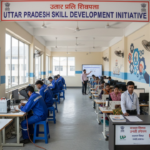
The Economic Impact of Political Decisions Made in UP : How policy choices in Uttar Pradesh shape the state’s economy and influence India’s growth.
Introduction
As India’s most populous state and a significant contributor to the national economy, Uttar Pradesh (UP) holds a pivotal role in shaping the country’s economic trajectory. With its ambitious vision of becoming a $1 trillion economy, political decisions in UP have far-reaching implications, not just within its borders but also across India. This article examines how the state’s political choices influence economic policies, sectors, and development.
Key Political Decisions Influencing UP’s Economy
1. Industrial Policies and Investment Promotion
The Industrial Investment and Employment Promotion Policy 2022 has been a cornerstone of UP’s efforts to attract businesses and boost economic growth.
- Highlights:
- Tax incentives for industries.
- Capital subsidies for investments in backward regions like Bundelkhand and Purvanchal.
- Single-window clearances for ease of doing business.
- Impact:
- The UP Global Investors Summit 2023 attracted investment proposals worth ₹4.68 lakh crore, with projects spanning manufacturing, logistics, and IT sectors.
(Source: UP Investors Summit)
2. Infrastructure Development
Political leadership in UP has prioritized infrastructure projects as a driver of economic growth.
- Major Initiatives:
- Jewar International Airport: Expected to boost tourism and logistics sectors.
- Expressways: Projects like the Ganga Expressway and Purvanchal Expressway are enhancing regional connectivity and reducing logistics costs.
- Economic Impact:
- Improved infrastructure attracts industries, boosts exports, and generates employment.
- These projects are projected to create over 1 million jobs in the next decade.
(Source: UP Expressways Industrial Development Authority)
3. Focus on MSMEs
Political policies like the One District One Product (ODOP) initiative have revitalized UP’s micro, small, and medium enterprises (MSMEs).
- Key Features:
- Promotes unique products from each district, such as Banarasi silk and Moradabad brassware.
- Financial and marketing support for artisans and MSMEs.
- Results:
- MSME exports from UP surpassed ₹1.56 lakh crore in 2022, contributing significantly to the state’s GDP.
(Source: Ministry of MSME)
Economic Sectors Most Affected by Political Decisions
1. Agriculture
Agriculture remains the backbone of UP’s economy, employing over 50% of its population.
- Policy Impacts:
- Loan waivers and input subsidies have provided short-term relief to farmers.
- Investments in agri-tech and irrigation projects under the Krishi Sinchayi Yojana aim to modernize farming practices.
- Challenges:
- Over-reliance on subsidies may strain the state’s budget.
- Political focus on wheat and sugarcane often sidelines diversification into higher-value crops.
(Source: NITI Aayog)
2. Urbanization and Real Estate
Political decisions encouraging urban development have led to rapid growth in cities like Noida, Lucknow, and Kanpur.
- Policy Drivers:
- Affordable housing initiatives under PM Awas Yojana.
- Development of industrial corridors and smart cities.
- Economic Benefits:
- Real estate growth boosts allied industries like cement and steel, contributing to overall GDP.
3. Employment and Skill Development
Programs like the UP Skill Development Mission (UPSDM) focus on creating a job-ready workforce to meet industrial demands.
- Achievements:
- Over 1 million youth trained in fields like IT, logistics, and advanced manufacturing.
- Skill initiatives align with industries established under the state’s industrial policies.
(Source: UPSDM Annual Report 2023)
Challenges in Balancing Political Decisions and Economic Goals
1. Fiscal Discipline
Populist measures like loan waivers and free electricity schemes often strain the state’s budget, reducing funds for infrastructure and development.
2. Regional Disparities
Economic growth is concentrated in urban hubs, while backward regions like Bundelkhand and Purvanchal still face developmental challenges.
3. Dependence on Political Cycles
Frequent policy shifts with changes in political leadership can disrupt long-term economic planning.
Strategies for Sustainable Economic Growth
1. Inclusive Regional Development
Targeted investments in underdeveloped regions can balance growth across the state, reducing disparities.
2. Focused Skill Development
Enhancing workforce capabilities through advanced skill programs can attract high-value industries.
3. Policy Continuity
Ensuring consistency in economic policies across political cycles can foster investor confidence.
Expert Opinions
- Economist’s Insight:
- “UP’s economic growth depends on its ability to sustain infrastructure development while managing fiscal responsibilities.”
- Political Analyst’s Perspective:
- “Political decisions in UP have a ripple effect on India’s economy, given the state’s size and influence. Balancing populism with pragmatism is crucial.”
(Source: PRS Legislative Research)
Conclusion
The economic impact of political decisions in Uttar Pradesh is both profound and far-reaching. While policies promoting industrial growth, infrastructure development, and MSME support have set the stage for progress, challenges like fiscal discipline and regional disparities must be addressed. By prioritizing inclusive growth and ensuring policy continuity, UP has the potential to not only achieve its $1 trillion economy vision but also significantly contribute to India’s economic future.

